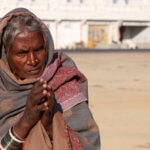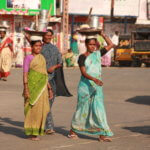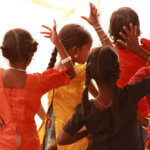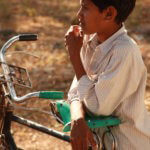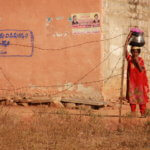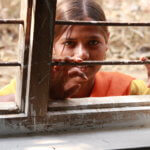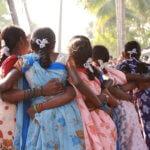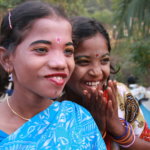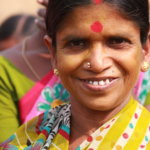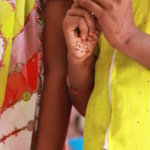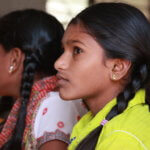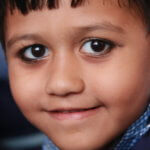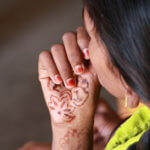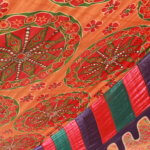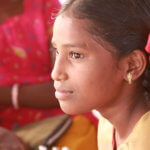Words and photos by Sarah Sekula
It’s day three in India. I’m on a rickety bus in the depths of the Nallamalla Forest. My BlackBerry has no signal. Our guide has warned us of tigers and lions lurking among the foliage. And now, I suspect, the giant vehicle’s underbelly has scraped the ground one time too many. Our bus, Sri Lalita (better known as the Hindu goddess of bliss), has given up.
After my brief moment of panic, I realize two things: We are merely stopping for an early-morning, out-in-the-open potty break. And we are nearing our destination: Visakapatnam (or, as the locals say, Vizag).
It’s New Year’s Day. The sun is rising, the air is fresh and sea breezes flow through the cracked windows. We’ve been on this bus for 10 hours now. And by “we,” I mean a group of 25 strangers. There’s the skinny-jeans-wearing photographer from New York, a Seattle-based drummer from The Classic Crime, a lively mom from Pittsburgh, two Australian college students and 17 others. We are all here for a purpose: to learn more about ways to prevent human trafficking, or modern-day slavery.
Restoring Childhood
Our next stop: Kodumuru Village. As we pull into the town, a dusty assembly of half-torn-down houses and mud-walled huts, young girls and boys wait in hopes of a high-five or an autograph. From the outset, it is apparent that we are a spectacle — a traveling circus of sorts, since none of the villagers had ever seen a Westerner.
Dozens of kids eyeball me with intense curiosity and loads of giggles. They study my every move: I put on sunscreen; they stare. I do the silliest dance I can think of (the running man); they mimic. I blurt out the traditional Hindu greeting “Namaste.” They shout back, “What is your name?” “Saraaah,” I say slowly. “That’s a very good name,” one boy tells me with a flash of brilliantly white teeth.
I’m surprised to discover what they’ve picked up from Western television. “WWF. Smack down!” they yell as they kick up dust in their excitement and shuffle through their trading cards.
Among all the music, joy and outright giddiness, it’s hard to imagine that just a short while ago most of these kids were pieces of property — toiling away as bonded slaves in the surrounding community. That is, until Vijay Kumar stepped in. A 51-year-old, mild-mannered social worker wearing wrinkled khakis and sporting a fussy mustache, he is our intrepid leader for the trip.
He explains, parents end up being tricked into taking a loan for as little as the cost of medicine for a sick child. Many never pay off the loan, and it is passed down through the generations. This is why so many children here are enslaved.
“We help find donors to clear such debts,” say Prem, Viyay’s 25-year-old son. And, one by one, the Kumar family saves the children from 16-hour workdays and brings them to a school, where they learn and gobble up naan bread, chicken and rice.
With us today, the children are dribbling soccer balls, doodling on the walls with chalk and singing enthusiastically. Most important, they have hopped back into childhood, where they should have always been.
Steps to Liberation
Just a few days earlier, Vijay and Prem welcomed us at the Rajiv Gandhi Airport on the outskirts of Hyderabad, one of India’s fastest-growing cities. Our four-hour bus ride to Kurnool provided plenty of time for Vijay to fill us in on his mission to eradicate child abuse and human trafficking.
As we fall into easy conversation, he explains his work to free dozens of slaves each year. But, sadly, his successes are small when you consider the total slaves out there: an estimated 27 million worldwide. That’s more than twice the number of people taken from Africa during the entire 350 years of the Atlantic slave trade.
An hour into the journey, we stop at Shadnagar Village for chai — a delectable tea made with boiled milk and sugar. This is also the moment I realize the scant distribution of trash cans in India. “Where should I put my garbage?” I ask. “Throw it on the ground,” Vijay raises his arms and says matter of factly. “This is India.”
The culture shock slowly sets in as the bus shuttles us deeper into India and far from the couture fashion shows and corner art galleries of Hyderabad. Along National Highway 7, we pass the temples of Jadcherla and the wild landscapes of Kothakota, not to mention a few hundred grueling miles of overwhelming dust and smog.http://sarahsekula.com/freedom-found/
But the dirt and grime is nothing compared to the surrounding sea of traffic and chaos. Our driver, always quick to lay on the horn, weaves past dozens of goods carriers and giant trucks labeled “King of the Road,” so closely we could’ve easily high-fived the passengers.
The locals don’t seem to notice, though. Men leisurely walk arm-in-arm or hang out at the roadside barber shops the size of backyard sheds. Women wearing candy-colored saris balance bulky baskets of fruits on their heads. And youngsters chase our giant tour bus.
That afternoon, we reach Kurnool, a 2,000-year-old city and one of India’s poorest. Arriving at our hotel, we hop off the bus to a welcome of exhaust clouds and a young and persistent “street urchin.” Not far away is a watchful adult. He will likely scoop up any rupees the child brings back.
Humanity at Its Worst
The next morning, I’m jolted out of bed at 5 a.m. The Muslim call to prayer blares from distorted loud speakers. Dog yelp. Rickshaws toot. Clearly, the city is awake.
Already dust-covered and slightly sweaty, we arrive at St. Joseph’s Urchins Welfare Association by 9 a.m. for our first cultural exchange. Inside, the young girls — many of whom are HIV-positive trafficking victims — wear saris or lengas (flowing skirts) and delicate jewelry. They begin a dance full of explosive movements. Outside, under a brilliantly colored tent, the conversation is more serious.
“The caste system is prevalent in all of the villages we will visit,” Prem prepares us. “Fraudsters try to cheat the villagers by claiming a God appeared and is not happy with the family. He then tries to convince them to do meaningless rituals and demands money. Unfortunately, they also lure young girls into the sex trade.”
It’s humankind at its lowest. And it is what has happened to many of the women in this village. Others come into slavery with the false promise of work, says Kevin Bales, president of Free the Slaves, a human rights group founded in 2000.
The Lights Come On
“Slaveholders slink into town, asking, ‘Who needs a job? Who wants to work?’ he says. “And so the villagers climb into the back of the truck,” Bales explains, “and later they find there is no job, there is no pay. And when the brutality begins, they understand they are being enslaved.”
The lucky ones who escape their slaveholders are shunned from society, leaving places like St. Josephs as their only hope. “Even their own parents don’t accept them back,” says Vijay. “They think [it better to allow such a] girl to die than live and tarnish their image.”
It happens all too often in India. In total, there are an estimated 8 to 10 million slaves countrywide. “In Kurnool,” Vijay says, “every 10 kilometers we find 100 girls involved in the flesh trade. With no proper jobs and money to support the family, parents sometimes are forced to sell their girls to the pimps.”
Once they are freed, it’s like they are in shock 24 hours a day. “It’s just the most beautiful thing,” says Bales. “The lights come on. The dreams start to happen. One of the first slaves I interviewed did not know there were seasons. She didn’t know the names of the days. It’s almost impossible to understand the oppression.”
True Heroes
Back in Vizag, we visit Vijay’s home, a humble two-story dwelling, packed wall to wall with family, neighbors and the 25 orphans who live there. The second floor of the home is cleared out during the day for lessons and play. At night, the girls use mats as makeshift beds. One 16-year-old, Laxmi, sitting in the corner, suffers from polio. Although she can’t get up and dance with the others, her smile is radiant enough to light the room.
As I gulp down my daily cup of chai tea, I am in awe. Here is a family making a huge difference on a shoestring budget. But what if powerful people from around the world stepped in? What if the firebrand liberators like Vijay and his family had an abundance of supplies? How many more slaves could be saved then?
Of course, those ponderings are balanced with a few touristy prerequisites. We dance around on the rooftop, get fitted for saris and are decorated with henna tattoos. As a young girl applies the swirly designs to my hands, she discusses the hour-long drying process (which she says I should be very careful about, if I want to “find a good mate”). “The darker the stain, the better the husband,” she says with a giggle. So I wave my henna hands in the air and wait exactly an hour to peel off the black, puffy substance and reveal the lovely orange designs.
“One day I wish to see a big change in this country,” Vijay says, emphatically. Until then, he tells me, he will continue eating one meal a day so he doesn’t forget the millions who don’t have even one chapatti to nibble on. He will sleep on a mattress on the floor to remind himself of those suffering on the streets. And he will make a point of staying in the mud huts with the “people who are living the most miserable lives. It leads me to thank God and be grateful to Him always from the depth of my heart for all my blessings.”
Vijay — an ordained pastor, fluent in English, Hindi and Telugu —hails from a life of poverty himself. His ultimate goal now: make sure others don’t have to live that way. So, he rehabilitates slaves by providing typing instruction, English classes and other vocational necessities.
“I have experienced the [overwhelming] joy and happiness in the depth of my heart when someone who is in real need is being helped,” he explains. “This feeling, I would never have even if I get millions of rupees or dollars in the lottery.”
We depart for home Jan. 5, peppered with bug bites, dizzy with wide-ranging emotions and weary with exhaustion. In a daze, I watch more sights whiz by: Lepers and widows sit in the shade. Women saunter by with yellow-painted faces. Cows are decked out in necklaces.
Lessons Learned
Once we are settled on the plane for the return flight, the attendant passes by, aerosol can in tow, and sprays down the cabin. Strange, I think — until I remember how bad I must smell. I pop a few melatonin pills to help with sleep. My thoughts collide until I drift into a state of utter grogginess.
Seeing up close what slavery looks like has left my heart heavy. Meeting children who know 16-hour workdays better than their native language is mind boggling.
The far-flung travel brought things into focus. Before the trip, I felt helpless. My first thought: This is impossible. What could I do that would have any effect? How do you reverse something so widespread and horribly corrupt?
Well, there’s an upside to that feeling of desperation. It’s the eventual eureka moment when you realize that you don’t have to be helpless. You can do something. There are solutions, and the first step is awareness. Telling people about trafficking is a way to save lives.
Let’s be clear: Our group didn’t have a false ideal of bringing revolutionary change to India; we left it the way we found it. The metamorphosis, instead, took place within ourselves. These words of Nelson Mandela sum it up quite nicely: “There is nothing like returning to a place that remains unchanged to find the ways in which you yourself have altered.”
It lit a fire within our hearts to do something. Take Ashlea and Sara, for example. They are raising money for Laxmi, the orphan living at Vijay’s house who is crippled by polio, so she can have regular doctor’s visits. Amy will head to Kolkata this summer to teach art therapy to trafficking survivors. Rita has launched a campaign to spread awareness among college students across the nation.
Twelve days so far from creature comforts of home, confronted with India’s oddities and social injustices, gave me plenty of time to think. On the last day it hit me: The pressures of Third World travel — outlandish smells, language barriers, even the lack of toilet paper — had taught me something. Happiness is simple, especially in our world of luxury. If the slum survivors of India can find it, anyone can. It’s the occasional game of soccer. Three meals (or more) a day. The chance to go to school. Most of all: It’s freedom.

